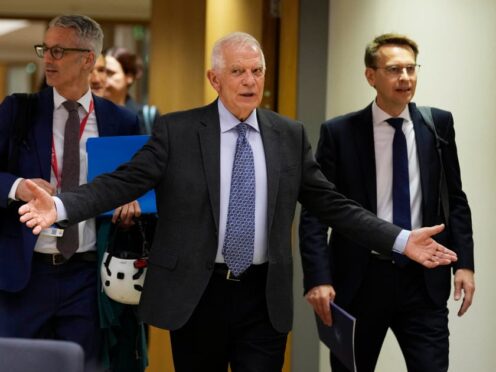The European Union is pressing ahead with a plan to use the profits generated from billions of euros of Russian assets frozen in Europe to help provide weapons and other funds for Ukraine, a senior official said.
EU foreign policy chief Josep Borrell got a green light for the plan from most of the bloc’s foreign ministers this week, and he hopes that EU leaders will endorse it at a summit in Brussels starting on Thursday.
The move comes as Ukraine runs dangerously low on munitions, and US efforts to get new funds for weapons have stalled in Congress.
The #FAC approved my proposal for a €5 billion #UkraineAssistanceFund.The Fund will support Ukraine in getting the military equipment it needs to defend its people & its right to exist as a state against Russian aggression.We turn our words into action.https://t.co/u3ojO4YySW
— Josep Borrell Fontelles (@JosepBorrellF) March 18, 2024
The 27-nation EU is holding around 200 billion euro (£171 billion) in Russian central bank assets, most of it frozen in Belgium, in retaliation for Moscow’s war against Ukraine.
The bloc estimates that the interest on that money could provide around three billion euro (£2.5 billion) each year.
“The Russians will not be very happy. The amount of money, three billion per year, is not extraordinary, but it is not negligible,” Mr Borrell told reporters.
A small group of member countries, notably Hungary, refuse to supply weapons to Ukraine, so these windfall profits would be divided up.
Around 90% of the money would be put into a special fund that many EU countries already use to get reimbursed for arms and ammunition they send.
The other 10% would be put into the EU budget to help bolster Ukraine’s defence industry. Countries that object to sending weapons could then claim that they are not arming the country, Mr Borrell said.
The EU budget cannot be used to buy arms, under current expert interpretations of the bloc’s treaties, but the special fund — known as the European Peace Facility — runs off-budget and does not have to respect the same legal standards or be approved by the European Parliament.
The European Central Bank, or ECB, has warned in the past against seizing Russian assets as this could undermine confidence in the euro currency and EU markets.
But Mr Borrell said that no assets would be taken, only the windfall profits they make. He added that the ECB has been consulted on the plan.
Some EU leaders, including Belgian Prime Minister Alexander De Croo, have said that they want to use the windfall profits to fund Ukraine’s reconstruction, but Mr Borrell said he believes that “the best thing is to avoid that anything is destroyed” in the first place.
